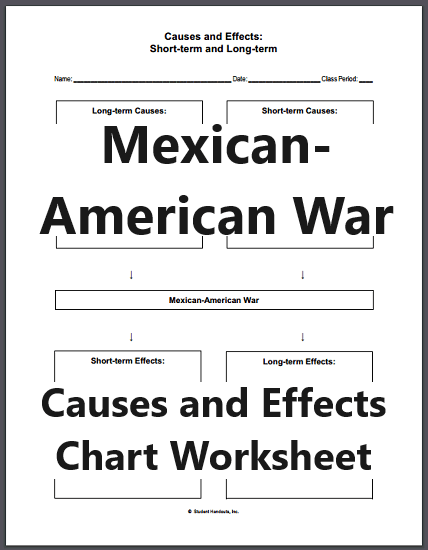The Mexican-American War, which took place from 1846 to 1848, had both short-term and long-term causes and effects that significantly impacted both the United States and Mexico.
Short-Term Causes:
- Border Disputes: The immediate trigger of the war was a dispute over the Texas-Mexico border. The United States had annexed Texas in 1845, but the border was a subject of contention. The U.S. claimed the border was the Rio Grande, while Mexico argued it was the Nueces River.
- Manifest Destiny: The ideology of manifest destiny, the belief that it was America's destiny to expand westward to the Pacific Ocean, played a significant role. Many Americans saw Texas and other Mexican territories as part of this vision.
- Incidents on the Border: There were several incidents along the disputed border that escalated tensions, including the Thornton Affair and the Matamoros Expedition.
Long-Term Causes:
- Mexican Instability: Mexico had experienced a series of political and economic upheavals in the decades leading up to the war. This instability weakened the Mexican government and contributed to its inability to defend its northern territories effectively.
- American Economic Interests: The United States had economic interests in California and New Mexico, and there was a desire to secure these territories for trade and access to Pacific ports.
Immediate Effects:
- Treaty of Guadalupe Hidalgo: The war ended with the signing of the Treaty of Guadalupe Hidalgo in 1848. Mexico ceded a vast amount of territory to the United States, including California, New Mexico, Arizona, Nevada, Utah, and parts of Colorado, Wyoming, Kansas, and Oklahoma.
- Border Confirmed: The Rio Grande was recognized as the border between Texas and Mexico, resolving the border dispute.
Long-Term Effects:
- Growth of the United States: The acquisition of the Mexican Cession greatly expanded the territorial size of the United States, contributing to its westward expansion.
- Sectional Tensions: The question of whether the newly acquired territories would allow slavery or not deepened sectional tensions between the North and the South, eventually leading to the American Civil War.
- Impact on Mexican Territory: Mexico's loss of territory had a profound impact on its national identity and territorial integrity. It exacerbated existing economic and political challenges in Mexico.
- Legacy of Animosity: The war left a legacy of animosity and distrust between the United States and Mexico, which continued to affect their relations in subsequent years.
- Infrastructure and Development: The acquisition of California and the Southwest contributed to the development of infrastructure, mining, agriculture, and urbanization in the newly acquired territories.
- Increased Immigration: The Mexican-American War also led to an increase in Mexican immigration to the United States, particularly in the newly acquired territories. This contributed to the cultural diversity of the region.
- U.S. Military Leadership: The war provided valuable experience for future military leaders on both sides, including Ulysses S. Grant and Robert E. Lee for the United States and Porfirio Díaz for Mexico.
The Mexican-American War had profound and lasting effects on the territorial expansion of the United States, sectional tensions, the development of the American West, and the relationship between the United States and Mexico. Its consequences are still felt today in the border region and the cultural and political dynamics of the American Southwest.
|











